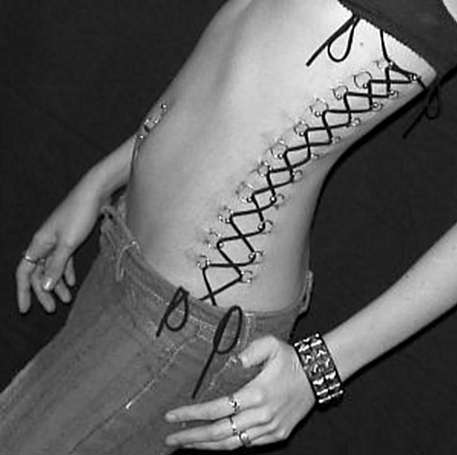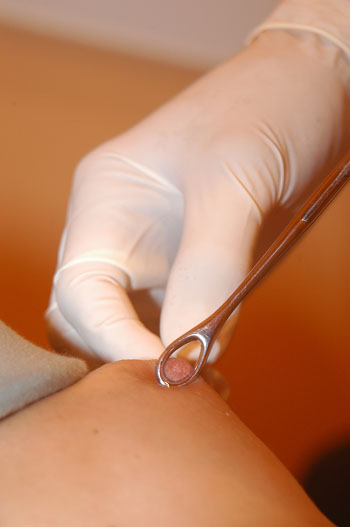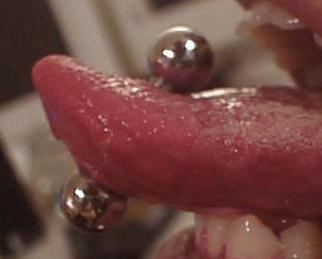
Body piercing has grown so much in popularity in recent years that it has become almost mainstream, with more and more people sporting navel rings and multiple ear rings. Facial piercings, surface piercings and lots of others to choose from can make things confusing. If you don’t know what to expect when you decide to get a piercing, it can be even more intimidating. Here are some of the top questions people have about body piercing.
1. I want to get a body piercing. How much will it cost?
The cost of a body piercing varies depending on several factors, including where you’re located, how close to a major city you are, and what kind of piercing you’re having done. Generally the more difficult the piercing, the higher the cost. Keep in mind that you get what you pay for as well, so don’t depend entirely upon cost to choose your piercer. If a piercer is charging significantly under the market cost in your area, he may be cutting corners in areas he shouldn’t, such as sterilization and other safety procedures.
On average, the cost of piercings fall somewhere in these ranges:
- Ears (lobes, cartilage, etc.).....anywhere from $25-$50
- Navel...................................$45-$55
- Tongue.................................$45-$55
- Labret..................................$50-$60
- Eyebrow................................$40-$50
- Nipple...................................$45-$55
- Nostril..................................$45-$55
- Genital..................................$75-$100
2. Does it hurt?
In simple terms, yes. Does it hurt much? Most people will tell you, “No, not really.” It’s usually more like a pinching or popping sensation than anything. The sensation of pain is relative—some people feel it more than others. The adrenalin rush of the piercing usually means the pain in minimal.
After the initial pain when the needle goes through the piercing, you may feel some dull pain or an aching sensation for a few hours, which can be relieved with an over the counter pain reliever. One piercing that does hurt a bit more than others is the tongue piercing, which will swell and be sensitive for a few days. Ice chips and popsicles will help soothe the pain of this kind of new piercing.
3. How long does it take a body piercing to heal?
 The healing time for a body piercing varies depending upon what you’ve had pierced. Some parts of the body heal more quickly than others. For instance, if you pierce your earlobes, you can expect them to heal within two months and be ready for jewelry other than the original piercing jewelry.
The healing time for a body piercing varies depending upon what you’ve had pierced. Some parts of the body heal more quickly than others. For instance, if you pierce your earlobes, you can expect them to heal within two months and be ready for jewelry other than the original piercing jewelry.
The belly button is in an area that heals slowly, however, because it’s right where the body twists and turns, which slows the healing process. It also doesn’t get as much air circulation because it is covered much of the time. It can take up to six months or even a year for a belly button piercing to heal completely.
Some general healing times are:
- Ear lobes..........6-8 weeks
- Cartilage...........4-8 months
- Eyebrow...........6-8 weeks
- Nostril..............3-4 months
- Septum.............6-8 months
- Labret..............2-3 months
- Tongue.............4-6 weeks
- Nipple..............4-6 months
- Navel...............5 months-1 year
- Genitals............6 weeks-6 months
The better you care for a body piercing, the more quickly it will heal, so be sure to discuss the proper care of your piercing with the piercing professional who does your body piercing to ensure a quick, clean piercing and you will heal in the least amount of time possible.
4. How can I tell if a piercing is infected, or it’s just normal healing stuff?
All body piercings will have some drainage during the first several days. This is because you have basically given your body a puncture wound, and your body will bleed for a while, and then have drainage of some fluids as it heals. These fluids are actually good for you, as they keep the area moist and clean and will wash away some of the dirt and germs that might otherwise stay in the area.
Bleeding should stop within a few hours or the first day and be only small amounts. Often it will look watery. Drainage will be mostly a clear, watery discharge, although it can sometimes be somewhat white in color. The drainage will form “crusties” around the jewelry that can be washed off with warm, soapy water when you clean your piercing each day.
A piercing is infected when the discharge is either green or yellow. Also, if the area becomes swollen or inflamed again after the initial swelling has subsided. Any time you see green or yellow pus or discharge; you should see a doctor and get appropriate medical treatment. It won’t necessarily mean you have to remove your piercing; you may simply have to take a course of antibiotics. If the area becomes red and inflamed with red streaks radiating out from the area, see a doctor right away.
5. What should I look for in a good body piercing studio?
A good body piercing studio must first and foremost be clean, clean, and clean! The most common cause of infection is piercings is simple exposure to germs, so look for a piercing parlor that is very strict about its cleanliness and sterilization procedures. They should have a separate room where nothing else is done but piercings.
They should always have an operational autoclave, which is a wet steam sterilization unit that is to be used to clean and sterilize all tools and equipment used during piercing. They should also pierce only with single-use, disposable needles that are pre-wrapped. Ask them if this is what they use, and insist that the needles not be opened until they are actually ready to do your piercing so that you can confirm they are sterile-wrapped.
Look for experience and qualifications. Have all the piercers been through an apprenticeship program? If so, for how long did they train and where? Also make sure they are licensed to operate a piercing studio by their state’s department of health. In most states this is now mandatory. Also check the date to make sure it isn’t expired. Finally, look for a certificate of membership in a professional society such as the Association of Professional Piercers, an organization that supports safe and professional piercing practices and offers extensive ongoing training.
6. Why can’t I just pierce myself?
 You can pierce yourself, but it’s not really a good idea. It’s simply too hard to keep the area in your own home (or wherever you happen to be) clean and sterile enough. You also may have trouble lining up and placing a piercing squarely where you want it, and if you lose your nerve half-way through the piercing, you’re stuck with it half done.
You can pierce yourself, but it’s not really a good idea. It’s simply too hard to keep the area in your own home (or wherever you happen to be) clean and sterile enough. You also may have trouble lining up and placing a piercing squarely where you want it, and if you lose your nerve half-way through the piercing, you’re stuck with it half done.
If you do it at home, you’ll probably do it on an impulse, which will mean you won’t have the right tools. Piercing needles are incredibly sharp in order to reduce the pain and make a good, clean cut. No matter how sharp that sewing needle is at home, it’s not as sharp as a piercing needle, so it will hurt more, bleed more, and may not heal as cleanly.
7. What should I clean my piercing with?
Today most professional piercers agree that the best way to clean a fresh piercing is with a mild antibacterial soap. These should not contain perfumes or dyes, which can irritate a piercing and lead to discomfort or an allergic reaction. There are a few on the market that are specifically designed for body piercings, including Provon® and Satin®.
After cleaning, you should follow up with a sea salt water soak. Sea salt is available at natural health stores, piercing and tattoo studios and a variety of other stores. The sea salt solution helps soothe the area and draw impurities out of the wound to promote faster healing. H2Ocean is an excellent pre-mixed sea salt solution that can be sprayed on for ease of use. It’s highly recommended by many professional piercers and is convenient especially if you’re traveling or on the go.
8. What kind of jewelry should a piercing be done with?
 A body piercing is, in the simplest terms, a puncture wound, so you want to use a high quality metal that won’t react with your body chemistry to create an allergic reaction or contaminate the open wound.
A body piercing is, in the simplest terms, a puncture wound, so you want to use a high quality metal that won’t react with your body chemistry to create an allergic reaction or contaminate the open wound.
Never use cheap or base metals to get a body piercing. The best metals to use are titanium or surgical steel, both or which are essentially inert and won’t react with your body. In some cases, you can use high quality gold, but even this sometimes creates a reaction because of the nickel content, so do be cautious.
Once a piercing is completely healed, you have more leeway on what you can use, but if you are at all nickel sensitive, you will probably always have to stick with surgical steel and titanium for your body piercings, unless you are using alternatives such as glass, which is completely non-reactive and safe for nearly everyone.
9. What causes migration? Is it the same as rejection?
Rejection is a more severe form of migration. Migration is when a body piercing begins to move through the flesh because the body is trying to force it out of the skin and get rid of it. In some cases, the body only partially succeeds, and the piercing “migrates” so that it ends up being crooked or misaligned.
When the body completely forces a piercing out of the body, it is called a “rejection,” because the body has completely rejected the piece of jewelry, basically “spitting it out.” This is because any piercing jewelry is a foreign object that the body sees as an invader to be gotten rid of, especially if the piercing is poorly done so that the jewelry aggravates the skin tissues.
10. What if I want to become a professional piercer?
Behave responsibly. Visit a few piercing parlors that you know are top quality and ask about internship programs and other options. Order some videos that take you through the introductory steps of piercing and educate you on the process of proper preparation and sterilization. Many of the larger piercing websites offer these video series’ at a reasonable cost.
You should also take courses in first aid in blood borne pathogens and other illnesses that are commonly transmitted by needles. Many of these courses are offered through community colleges or local hospital extensions. The most important thing is to be fully trained and completely experienced in all manner of piercing before setting yourself up as a piercer on your own—both for your own legal protection and the safety and well-being of those who come to you for body piercing.
The Association of Professional Piercers (www.safepiercing.org) is an excellent source of information on how to get started as a professional piercer.
In Conclusion
 Body piercing and wearing body jewelry should be an informed choice, not a snap decision. If you have been thinking about getting a body piercing, talk to others who have done the same and get their feedback. Ask them if they are happy with the results and for their suggestions on good piercing studios. Ask yourself if you’re ready for the commitment to proper care and the expense of a body piercing.
Body piercing and wearing body jewelry should be an informed choice, not a snap decision. If you have been thinking about getting a body piercing, talk to others who have done the same and get their feedback. Ask them if they are happy with the results and for their suggestions on good piercing studios. Ask yourself if you’re ready for the commitment to proper care and the expense of a body piercing.
Remember that a body piercing is a form of body modification that will affect how others perceive you. Obviously, this is part of the appeal for most people. However, the reactions will be mixed, and you should keep in mind that while some people will love it, others will not. So think through the consequences of body piercing thoroughly before you proceed. Then, if you decide its right for you—follow the tips above for a safe, attractive body piercing you’ll be proud to wear!
 There are few ways of getting a tattoo off your skin, but none of them are easy, pleasant or simple….
There are few ways of getting a tattoo off your skin, but none of them are easy, pleasant or simple…. Laser: The Laser technique is the penetration and break up of the ink articles that were injected into your skin. Much like the Fade Away Method, the ink particles that are broken up by the laser are carried away by the body's natural systems and are disposed as bodily waste.
Laser: The Laser technique is the penetration and break up of the ink articles that were injected into your skin. Much like the Fade Away Method, the ink particles that are broken up by the laser are carried away by the body's natural systems and are disposed as bodily waste.My name is Adriana and I’m the creator and developer of Wirlyhome label. I’m jewellery and clothing designer, I’ve been working in the fashion industry for the last 9 years of my life, I went to fashion school in Canada, where I lived for 10 years, and 8 of those long years I worked as a fashion designer, illustrator and forecaster. I came back to Brazil last year to open my label Wirlyhome, and now after almost 1 year of hard work the label is finally picking up and we are getting some recognition.




































